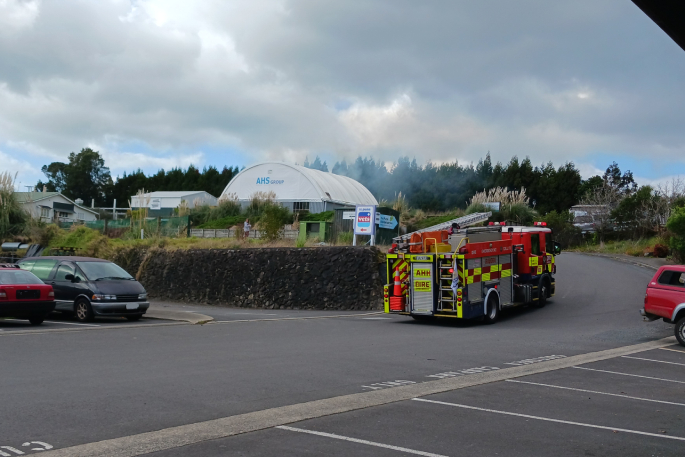Suspicious Shipping Container Fire Raises Alarm in Te Puna
A fire involving a shipping container at a commercial property in Te Puna was swiftly extinguished but has been classified as suspicious. The incident took place near the busy intersection of State Highway 2 and Minden Road, a location often linked to various freight and industrial activities. Fire and Emergency crews were quick to respond, putting out the blaze before it could spread or cause greater damage.
Timeline and Emergency Response
The fire was reported at 1:42 pm, prompting an immediate dispatch of firefighting units. According to the Northern Fire Communications Centre, three fire appliances were sent to the scene, with one unit coming from the Greerton station and two from Tauranga. Upon arrival, emergency personnel identified the fire as having originated from a shipping container located on the commercial site.
Thanks to the rapid actions of the firefighters, the flames were brought under control efficiently, with all fire units leaving the scene by 2:58 pm. Despite the fire’s swift containment, the response team noted the suspicious nature of the incident, though no fire investigator had been assigned at that time.
Details on Suspicious Circumstances and Site Conditions
While the cause remains under investigation, the fire’s suspicious classification raises questions related to security at commercial freight sites. Shipping containers are vital elements in cargo transport and logistics chains, so any fire or damage can disrupt supply routes and lead to substantial financial losses.
Implications of Shipping Container Fires on Logistics
Shipping containers are the backbone of global freight movement, securing goods whether they travel by land, sea, or air. A fire incident, even if promptly extinguished, can have cascading effects on logistics operations:
- Disruption of cargo schedules due to damaged containers
- Increased operational costs as shipments need rerouting or replacement
- Potential safety risks for personnel handling or working near affected areas
- Delays in freight delivery impacting client satisfaction and contractual obligations
Given the rise in containerized cargo transport, especially in commercial and industrial zones, such fires underline the importance of robust security and fire-prevention strategies at logistics hubs.
The Role of Rapid Response in Limiting Logistics Disruption
The quick reaction of fire services in this incident highlights how vital it is to keep emergency resources prepared and accessible near cargo transit points. When fire outbreaks occur in container yards or truck depots, every minute counts to prevent extensive damage to valuable shipments and infrastructure.
Safety Measures and Preventative Practices in Container Handling
Logistics and forwarding companies routinely implement fire safety protocols, including:
- Regular inspection of containers for hazardous materials and compliance
- Installation of fire detection systems around storage yards
- Staff training on emergency procedures and fire extinguisher use
- Maintaining clear access routes for firefighting vehicles
- Использование fire-resistant materials and adequate spacing between containers
These steps collectively reduce the risk of fire spreading and help to preserve both cargo and lives involved in the transport chain.
Summary and How It Connects to Cargo Transport Services
Rapid containment of the suspicious shipping container fire in Te Puna serves as a reminder of the vulnerabilities freight operations can face. Fires at logistics sites not only threaten valuable goods but also challenge the continuity of delivery and forwarding schedules. Maintaining vigilance, investing in safety, and ensuring emergency readiness are essential for minimizing risks.
Experience Outweighs All Opinions
Although reviews and second-hand reports paint part of the picture, true understanding grows from personal experience. With options galore in global cargo transportation, choosing a reliable and cost-effective service is crucial. Platforms like GetTransport.com offer a straightforward way to navigate these choices, providing affordable rates for international shipments, office and home moves, and even the transport of bulky items like furniture and vehicles.
What makes GetTransport.com stand out is the blend of transparency, affordability, and extensive service versatility — from parcels to pallet shipments and full container loads. This empowers users to make well-informed decisions without unnecessary costs or unpleasant surprises. Забронируйте поездку на GetTransport.com.
Forecasting the Impact on Global Logistics
While this particular shipping container fire may not shake the global logistics industry to its core, it highlights challenges any operator can face. Logistics depends on the safe, timely movement of goods, and incidents like these underscore the need for vigilance and continuous improvement in safety protocols. GetTransport.com stays tuned to such developments, ensuring the platform evolves with the dynamic world of freight and cargo transport.
Начните планировать следующую доставку и обеспечьте безопасность груза с помощью GetTransport.com.
Заключение
This recent occurrence of a suspicious fire at a Te Puna shipping container site serves as a case study on the importance of security and quick emergency response in logistics hubs. The incident demonstrates the vulnerabilities in freight operations and the domino effect such events can have on shipments, transport schedules, and overall supply chain reliability. Effective safety measures, rapid responses, and transparent logistics solutions are key to overcoming these challenges.
For those seeking dependable and affordable cargo transportation, whether for parcels, pallets, or bulky freight, GetTransport.com offers a practical solution. Its global reach, combined with user-friendly booking and cost efficiency, simplifies complex logistics needs while ensuring your deliveries are safe and on time. Partnering with such services means embracing reliable, streamlined transportation that stands ready to handle today’s dynamic freight challenges.

 Swift Response to Suspicious Shipping Container Fire on Commercial Property in Te Puna">
Swift Response to Suspicious Shipping Container Fire on Commercial Property in Te Puna">